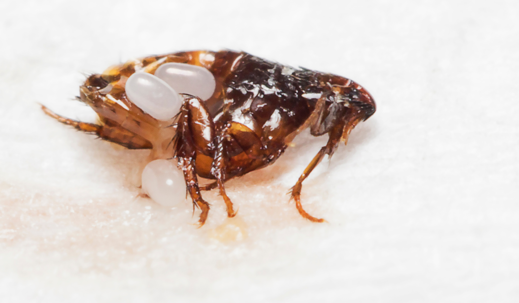How Do Exterminators Get Rid of Fleas?
Fleas are notorious for being stubborn pests, and getting rid of them can feel like an uphill battle. To eradicate fleas, exterminators employ a multi-step approach that includes inspection, treatment, and follow-up.
Curious about how to get rid of fleas and make your home pest-free? Stick around to discover the essential strategies of a professional flea extermination.
Key Takeaways
- Exterminators inspect critical areas to identify all stages of flea life and then treat them with targeted treatments.
- Combining chemical treatments and non-chemical methods can effectively address flea infestations.
- Regular follow-up visits ensure complete eradication, and ongoing preventive measures help avoid future infestations.
Step 1: Inspect and Assess the Area
Undetected fleas at home pose a health risk as they can be carriers of diseases like tapeworm and typhus.
So, exterminators start by thoroughly inspecting typical hotspots to determine the extent of the flea infestation. They look for signs of flea activity in various areas.
First, they check areas where pets sleep or spend much time. Fleas often lay their eggs in these spots.
Next, they move to carpeted areas, rugs, and upholstery. Here, they look for tiny specks of flea dirt (feces) or actual fleas.
Then, they examine cracks, crevices, and dark places. Flea eggs, flea larvae, and flea pupae in cocoons often hide in these hard-to-reach spots.
Lastly, outdoor areas, like your backyard, can also be a hotspot for fleas. They may check these areas and plan how to address the problem.
Each lifecycle stage requires different treatments. So, detecting all stages ensures that they can develop an effective plan.
Step 2: Treat the Home Environment
Pest control professionals offer a comprehensive approach (chemical and non-chemical methods) to provide long-term treatment against these pesky pests from the environment.
Product Treatments
Chemical treatments are crucial for directly targeting different stages in the flea life cycle. These treatments often include insecticides, which may require you and your pets to leave the house until it’s safe to return.
Applied to carpets, rugs, and furniture, here are typical chemical treatments they may use:
Chemical Treatments | Description |
Sprays | Applied to specific areas to kill adult fleas. |
Flea Foggers | Mist to cover large areas; targets hidden fleas. |
IGRs | Prevents larvae from developing into adults. |
Non-Chemical Methods
Non-chemical methods play a supportive role in flea eradication and help maintain a flea-free environment. For a deeper clean, they may recommend non-chemical methods like:
- Vacuuming: Frequent vacuuming removes eggs and larvae, especially in pet areas.
- Steam Cleaning: High-temperature steam kills fleas and their life stages on contact.
- Washing Fabrics: Regularly washing pet bedding, blankets, and other fabrics in hot water helps remove fleas and their eggs.
Step 3: Address the Source of the Infestation
Identifying and attacking the source of the flea infestation is crucial. While dog and cat fleas can hide in various places, they primarily target pets, so treating them is essential.
Use a combination of various treatments to ensure you cover all bases:
Flea Removal for Pets | Description |
Topical Flea Treatments | Applied directly to pets, these help kill fleas on contact. |
Flea Shampoos | Special shampoos that can kill fleas during bath time. |
Flea Collars | These emit a gas that repels and kills fleas on pets. |
Step 4: Follow Up and Monitor
After initial treatment, follow-up and monitoring are essential in flea control. This ensures that the fleas have been completely eradicated and helps prevent re-infestation.
They often schedule follow-up visits to re-treat the area if necessary. These visits allow them to check for remaining fleas and apply additional treatments.
As homeowners, you should also monitor your pets and living areas for fleas. You can regularly check for signs of fleas. Inform them immediately if signs of fleas persist. Timely communication can prevent a new infestation from taking hold.
Step 5: Take Preventive Measures
After calling in a professional for flea control services, you can take several DIY preventive measures to keep them at bay. Here’s what you can do as pet owners:
- Regular Cleaning: Vacuum of carpets, rugs, and furniture. Dispose of the vacuum bag or its contents immediately to prevent re-infestation.
- Diatomaceous Earth and Borax: Though results may vary, sprinkle diatomaceous earth or borax on carpets and pet bedding to kill fleas.
- Flea Combs: Continue using flea combs on pets to prevent fleas from coming back.
- Lawn Maintenance: Mow the lawn and trim vegetation to reduce the areas where flea populations can breed.
- Flea Prevention Products: Regularly employ flea prevention products such as topical treatments or oral medications for pets.
Is It Time to Call a Pest Professional?
Sometimes, no matter how hard you try, you can't tackle flea infestations alone. If fleas have taken over the house and your pets show signs of relentless flea problems, like flea bites or skin infections, it’s time to call a professional pest control company (like us at Native Pest Management).
As professionals, we use specialized equipment and treatments that aren't available over the counter. In addition to treating the present problem, we often offer advice on preventing future infestations.
So, when fighting fleas feels like a losing battle, remember that partnering with us provides not just relief but peace of mind.
